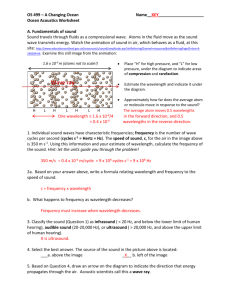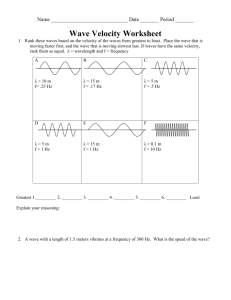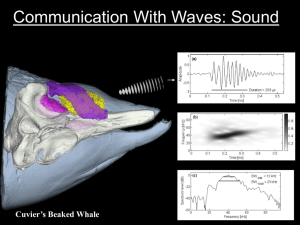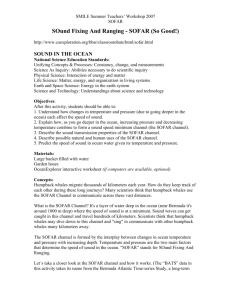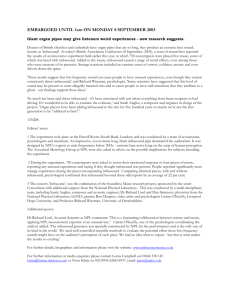Ocean Acoustics Worksheet
advertisement
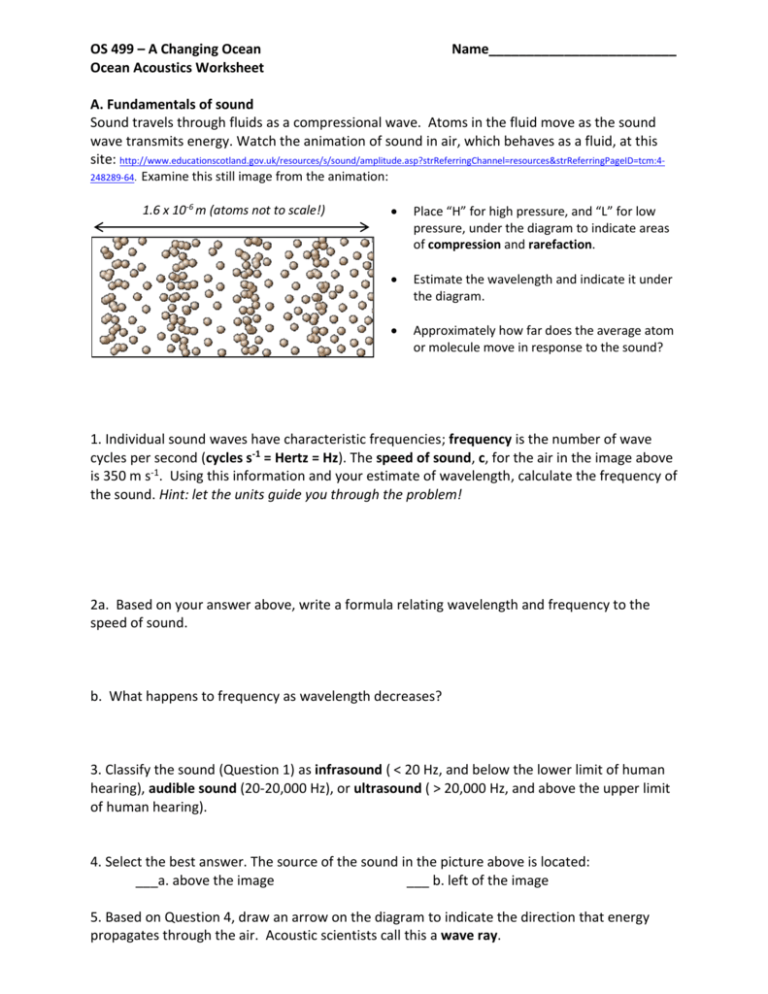
OS 499 – A Changing Ocean Ocean Acoustics Worksheet Name_________________________ A. Fundamentals of sound Sound travels through fluids as a compressional wave. Atoms in the fluid move as the sound wave transmits energy. Watch the animation of sound in air, which behaves as a fluid, at this site: http://www.educationscotland.gov.uk/resources/s/sound/amplitude.asp?strReferringChannel=resources&strReferringPageID=tcm:4248289-64. Examine this still image from the animation: 1.6 x 10-6 m (atoms not to scale!) Place “H” for high pressure, and “L” for low pressure, under the diagram to indicate areas of compression and rarefaction. Estimate the wavelength and indicate it under the diagram. Approximately how far does the average atom or molecule move in response to the sound? 1. Individual sound waves have characteristic frequencies; frequency is the number of wave cycles per second (cycles s-1 = Hertz = Hz). The speed of sound, c, for the air in the image above is 350 m s-1. Using this information and your estimate of wavelength, calculate the frequency of the sound. Hint: let the units guide you through the problem! 2a. Based on your answer above, write a formula relating wavelength and frequency to the speed of sound. b. What happens to frequency as wavelength decreases? 3. Classify the sound (Question 1) as infrasound ( < 20 Hz, and below the lower limit of human hearing), audible sound (20-20,000 Hz), or ultrasound ( > 20,000 Hz, and above the upper limit of human hearing). 4. Select the best answer. The source of the sound in the picture above is located: ___a. above the image ___ b. left of the image 5. Based on Question 4, draw an arrow on the diagram to indicate the direction that energy propagates through the air. Acoustic scientists call this a wave ray. B. Sound in water 1 One finds the speed of a compressional wave using this equation: c = √compressibility∗density The compressibility and density are those of the substance the wave passes through. Effect of temperature 1. Complete the sketch below to indicate how one could measure compressibility. Substance 2. Will a fluid be more or less compressible as temperature increases? _____________ Hint: think about the difference in compressing steam (heated water vapor) versus compressing moist air. 3. Will a fluid be more or less dense as temperature increases? ____________ Reflecting on your answers above, how does the speed of sound in water vary with temperature? Effect of salinity Do a thought experiment: Dissolve a spoon of salt in water. 4. Some water molecules move in response to the dissolution. Where do they go? 5. Do the molecules in the water become more or less ordered (i.e., arranged less randomly) after the addition of salt? _____________ A substance’s compressibility decreases as its atoms or molecules become more ordered. When salt dissolves in water, this produces a larger effect on the speed of sound than the accompanying change in density. Reflecting on your answers above, how does the speed of sound in water vary with salinity? Effect of pressure Use the same reasoning as for salinity (above) to deduce the effect of pressure on the speed of sound in water. C. Sound in the oceans – putting it all together For each pair of graphs, sketch the corresponding sound speed: The profile below shows sound speed at a North Atlantic station. Using your knowledge of temperature, salinity, and pressure in the oceans, and the graphs above, explain the variation in sound speed with depth. Sound in water is “lazy” – that is, wave rays trace paths towards the location of the slowest speed. “a” and “b” in the figure below are examples of ray paths in water. In “a”, sound speed is invariant and sound waves emit equally in all directions. In “b”, wave rays bend towards water depths with lower sound speed. Complete figure “c”, for a sound source originating in a region of low sound speed. The wave ray diagram in “c” (above) should show sound energy bending towards the depth where the sound originated. In the real ocean, wave rays travel more complicated paths but essentially do the same thing: they propagate long distances from the source in one direction along a “SOFAR” (“sound fixing and ranging”) channel. The SOFAR channel exists near the base of the thermocline in all the world’s oceans, centered on the low sound velocity zone. The image above shows sound speed for a circum-Pacific transect at 5o N. Draw a line on it to indicate the axis of the SOFAR channel (the sound channel axis). D. Whale talk 1. A whale near Asia communicates infra-sonically via the SOFAR channel with whales near Central America; one Central American whale answers. Roughly how long (in hours) must the Asian whale wait for a response? 2. The figure below likely shows a slightly more complicated sound transmission path than you imagined for the SOFAR channel. What does this new information shed on your answer to Question 1 (above)? Source: noaa.gov 3. Decibels (dB) are log-based measures of sound intensity. As sound travels from a source, it loses intensity (primarily through interactions with molecules and ions in seawater) and “attenuates”. Examine the attenuation graph below (for surface seawater, S=35 psu, T = 5oC, pH=8). Label the regions of infrasound, audible sound, and ultrasound. 4. Comment on why the whale above communicated in infrasound. 5. Certain whales, such as the one in the problem above, can emit infrasound at an intensity of around 200 dB. Estimate the attenuation, in dB or in percent, of the Asian whale’s 15 Hz call by the time it reaches the Central American whales. 6. Do a second estimate for a call of the same intensity at the high end of the audible range. Approximately how far will this call travel?
